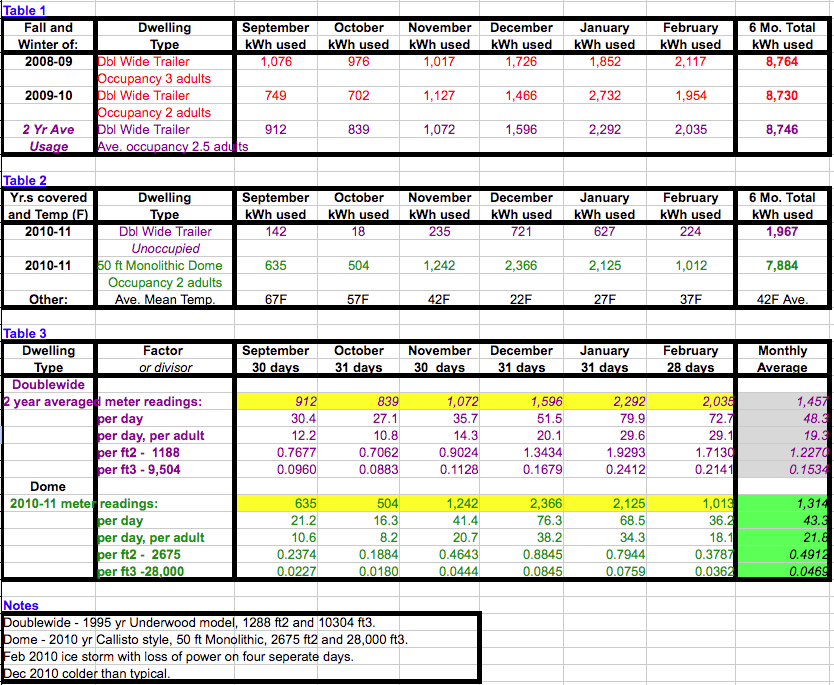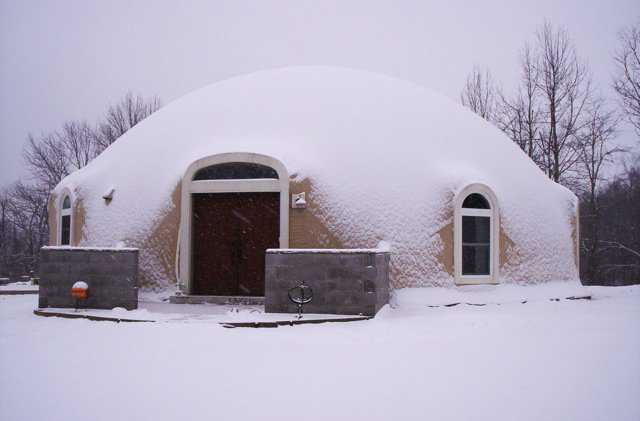The original Cold Study
In early 2010 my wife Maddy and I, as owners of a dome under construction, submitted our original Cold Study article to Monolithic. Now that we’re living in our furnished dome, we wanted to share more energy consumption data, again concentrating on the colder months in SW Virginia. These data are reported in the attached tables.
The data we compiled included over two years of utility bills while living in a 1188-square-foot, 15-year-old, doublewide trailer during the construction of our 2675-square-foot Monolithic Dome. In that first year of data collection, there were three adult occupants in the trailer, but there were only two adults for the second year. All utilities and appliances in the doublewide, and now also in the dome, are electrically powered. We took David South’s advice and avoided natural gas and propane appliances due to the airtight envelope provided by the Monolithic dome construction process and materials.
As spring breaks
We’re now at a point where we can share our two years of fall and winter months’ data in the doublewide, average these numbers, then compare them with our first fall and winter in our dome. I’ve also included the doublewide trailer’s unoccupied electric usage for this past season. Although empty, we kept the heat pump “on” to maintain interior temperatures above freezing to prevent burst water pipes. All other electrical breakers in the trailer were “off.” With the trailer and dome on separate utility meters, we were able to gauge the severity of cold weather – and December 2010 proved a chilly wake-up call. The trailer’s December utility consumption – just to heat the trailer to a meager 45F degrees – was equal to all utility usage for the previous June while occupied!
Considerations to keep in mind while reviewing the data:
There were periods of interrupted utility power in February 2010, while living in the trailer. If “normal” usage had remained uninterrupted, the electric usage would have likely been 2000 kWh for the month. The figure reported, however, was the actual meter reading.
Besides a gain in square footage (from 1188 to 2675) we also gained a lot of volume when we relocated to the dome. The trailer volume is 10,304 cubic feet, and the dome comes in at 27,500 – 28,000 cubic feet. There’s a little uncertainty on my part to account for augmented windows and doors. From these two figures, I selected the 28K cubic feet to calculate on the side of caution. If I’ve factored wrong, then we actually used less energy per cubic foot than reported.
Although utility meters were read on varying days of any particular month by our utility provider, I elected to use calendar days per month for consistent calculations across the years.
Dome heating was achieved with one, two or three 1.5kW space heaters, as needed, and passive solar gain on sunny days through our south facing 72’ 2" slider. The average indoor dome temperature was 64F degrees for the entire period. Our daily temperature would dip one degree at night, then return the next day with the sun.
The average mean exterior temperatures for the 2010-2011 months covered are listed in the tables for comparison.
Having spent time as a meter reader and utility analyst some years ago, I elected to report our electric usage into four categories: 1. per day, 2. per adult, per day, 3. per square foot and 4. per cubic foot. Each of these categories uses kWh (kilowatt hours) as a usage unit. These four categories keep the data consistent, regardless of changes in utility prices, tax changes, etc. that dollar amounts could confound, if reported. For those that can’t stand the suspense, on average we paid $135 for an all electric 2675-square-foot dome these past six months. Obviously your cost would vary by usage, provider and region, but this is comparable (or less) to what we paid in the doublewide.
Some general observations:
Even with higher than expected electric usage this past December, our dome proved more efficient per square foot and per cubic foot than the trailer. There was an undetermined increase in usage for December as I experimented with under-tile heating in small areas of the dome.
On average we are consuming practically the same or less electric than we consumed in the doublewide trailer, despite an increase of over 675 square feet of living space (not including over 700 square feet of loft area!) and an increase of at least 17,200 cubic feet. This fact alone is a tremendous savings factor for anyone considering dome living.
Beyond the comfortable interior temperatures, there are no drafts in the dome. Winter winds in this region often run in the 20 mph range and gust above 30 mph. These winds were very noticeable while living in the doublewide.
We had absolutely no worries about the integrity of our dome’s roof during the heavy snowfall this past January. Other traditional structures didn’t fare as well under the weight of accumulated snow.
The months reported, September – February, should be the months when we require the most electric consumption due to using the electric heaters. We didn’t need air conditioning during final construction last July and August; only ceiling fans were used to cool the air. I fully expect that our winter heating requirements would be less if we had more family members inhabiting the dome to generate more ambient heat from increased daily living activities. We intentionally planned and built this slightly larger dome to be marketable for a full family one day.
We expect future winter electric demand to steadily decrease as we will use our dehumidifiers less. Depending on interior humidity readings, we operated one or (often) two 50-pint dehumidifiers. Two of these units require the same electric as one space heater.
All in all, we’re very satisfied with our dome’s energy efficiency during these colder months, and we’re looking forward to a full year’s worth of energy savings to share with our neighbors, friends and curiosity seekers later this year.
Read Chris Ecker’s third story: A Year of Energy Data for a Monolithic Dome

To outfit their home, the Eckers used universal design products that can be comfortably used by virtually anyone at any stage of life.

This data clearly illustrates that domes typically use 1/2 the energy or less to heat.
